With orange alerts and non-seasonal rainfall on the rise, urban local bodies (ULBs) must act swiftly to prevent urban chaos.
Challenges Associated with Urban Local Bodies
- Reactive Measure: Most interventions remain post-facto, underscoring the need for a resilient urban governance framework.
- Constitutional Mandate: The 12th Schedule of the Constitution mandates that urban planning, flood control, and drainage fall under ULB responsibilities.
- Limited Preparedness: Weak infrastructure maintenance and inadequate response mechanisms worsen the condition of urban spaces during rainfall.
- Funding Gaps: ULBs face a shortfall of 42% between resources and expenditures, per the 2024 CAG report.
- Only 29% of ULB spending is allocated to programmatic and development activities, stalling infrastructure progress.
- Lack of True Devolution: Despite the 74th Constitutional Amendment, most states fail to devolve the urban planning function to ULBs.
- Heavy Dependence: ULBs generate only 32% of their revenue, highlighting their reliance on state transfers for basic operations.
- Drainage Failure: Heavy rains expose the fragility of urban infrastructure, with garbage-clogged drains and rising public health risks.
- Lack Uniform Adoption: The Urban Flooding SOP (2017) by the Ministry outlines a three-phase strategy but remains non-binding and unevenly implemented.
SOPs for Urban Flood Management
- Pre-Monsoon: Risk-Based Mitigation: This phase emphasizes planning based on geography, infrastructure audits, and preventive works.
- During-Monsoon: Real-Time Response: Includes warning systems, citizen alerts, and rapid deployment of relief operations.
- Post-Monsoon: Recovery and Rehabilitation: Focused on infrastructure restoration and rehabilitation of impacted communities.
Way Forward
- Targeted Risk Identification: Effective urban flood response begins with assessing local infrastructure weaknesses and vulnerable populations.
- Decentralised Model: Localised planning and risk mitigation often outperform large-scale macro interventions in complex urban settings.
- Odisha’s Model: The state has marked waterlogging-prone areas and deployed emergency equipment for swift response. The plan includes desilting drains, covering open drains, and deploying shelters for vulnerable groups.
- Zonal Level Monitoring: Zonal officers and 24/7 control rooms have been activated to manage emergency responses in real-time.
- Disease Control: Odisha’s plan integrates larvicide spraying and fogging to control mosquito-borne diseases in stagnant water zones.
- Volunteer and SHG Engagement: Local volunteers and self-help groups are key to improving community involvement and public awareness.
- Fiscal Empowerment: For ULBs to be effective, they need fiscal decentralisation, medium-term planning, and revenue stream diversification.
- Enhanced Monitoring : Using finance management systems and audits ensures transparent fund utilisation and targeted service delivery.
- Role of Center: While the Centre may fund strategic initiatives, actual execution rests with states and ULBs.
- Role of States: States Must Emulate Odisha’s Best Practices. States should clean drains pre-monsoon, remove encroachments, and use historical data to prevent flooding.
- Coordination: Standby equipment for clearing debris and inter-departmental coordination is essential for seamless flood response.
Conclusion
India can learn from China’s sponge city model using green infrastructure like parks, wetlands, and permeable surfaces. Sustainable urban planning must include community consultation and ownership for long-term success.
![]() 31 May 2025
31 May 2025

